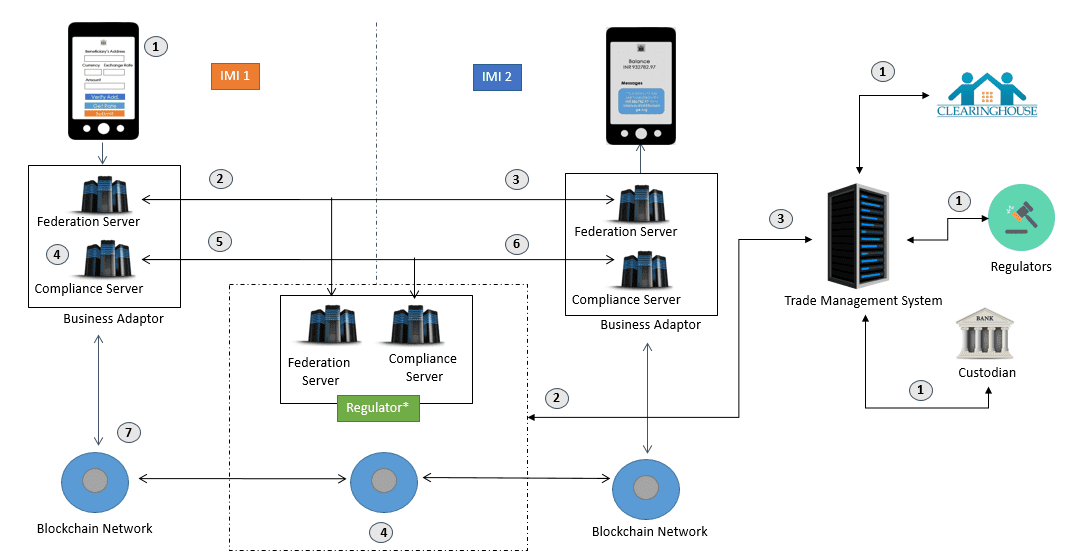HashCash Blockchain Solutions
In Wealth Management
Mutual Fund Investments and Securities Exchange
Mutual Fund Investments and Securities Exchange

Distributed Ledger Technology (DLT) or Blockchain can be implemented in a number of pragmatic ways within the wealth and asset management segment. The highly flexible Blockchain technology would enable the client to ensure an on-boarding process without significant friction. These distributed ledgers can streamline management of model portfolios, speed the clearing and settlement of trades while easing the compliance burdens concerning Anti-Money Laundering (AML) and Know Your Customer (KYC). This would enhance the client experience by abandoning redundancy and reducing operational expenses. Blockchain can be implemented to reconcile information through already existing systems and create opportunities for new markets and products. It can be included in transactions where assets are moved between parties or contracts are executed. These are typical to transactions involving rollovers, trusts, estates, and insurances. The distributed ledgers helps validate and execute complex transactions in near real-time. The smooth operation that Blockchain technology offers will enrich the client experience by streamlining different processes while significantly reducing operation costs,
Introduction

Recent explorations into innovative ways to enable quicker transactions and better customer service by organizations in the financial sector have benefits beyond just these. It prioritizes cost efficiency in its operations as well as maintaining utmost transparency that satiates the regulators and customers both.
Digitization of records has given birth to large volumes of data, making it extremely important for any organization to defy security threats while achieving superior cost efficiencies. These requirements are met by Blockchain, a technology providing decentralized ownership. With its immutability and cryptographic security of data, Blockchain has enabled the realization of the disruptive potential of this technology. The following paragraphs will discuss in depth, the different ways through which wealth and asset management firms can harness the benefits of Blockchain technology through real-world applications. The paper will also give an insight into approaching Blockchain innovation as well as highlighting near-term practical applications of the same.
Scope 1
HashCash
KYC & AML Management Systems
Scope 2
HashCash Open Architecture Investment Management Systems
Scope 3
HashCash Decentralized Automated Securities Trading Exchange
Scope 1
HashCash
KYC & AML Management Systems
Blockchain technology can be brought in to build and enrich a client profile that will surpass excellence. All confidential data points such as net worth, social media profiles, account information, preferences and profile data are allowed to be given access to with proper permission - to edit, read and write the data. Each data point and individual block of data is stored securely and can only be accessed through authorized permission.
Driving Factors
Client on-boarding has never been easier than with Blockchain. Wealth managers must go through a tedious verification of client identification by taking into consideration, sources of wealth, business interests, political affiliation, residency address proof, and many more. Verifying and collecting such volume of data often needs a time investment of days or even weeks.
CHALLENGES
- Strict onboarding requirements
- Proof of identification
- Residency
- Marital status
- Sources of wealth
- Occupation
- Business interests
MILESTONES
- Profile stored on a blockchain/distributed ledger
- Trusted parties are granted access to all or part of the profile based on cryptography
- New relationships would be initiated by profile owner
- The system inherently enables an audit trail for tracking changes to the chain. As a result, requiring fact-checking, such as AML, are simplified
- Integrate blockchain technologies into onboarding and ACH and ACAT systems and processes
BENEFITS
- Can facilitate many key functions of onboarding
- Client and risk profiling
- Financial planning
- Anti-money laundering checks and money movement
- Can enhance or possibly replace traditional systems, such as ACH and ACAT
- Enables near-instantaneous transfers of assets between financial institutions with authenticated provenance of tracked changes
Scope 2
HashCash Open Architecture
Investment Management Systems
Open architecture, in its definition, is the ability of a financial institution to offer its clients proprietary as well as external services and products. The perspective offers investment firms to get past the conflict of interest or favoritism, practicing which the firm may only recommend proprietary products.
Driving Factors
Wealth managers often face challenges regarding open architecture investment offerings. The rapidly multiplying facet of an open architecture as well as the third party investment models which are placed in separately managed accounts often is the harbinger of complex operational challenges. On the other hand, a distributed ledger technology enables the portfolio managers to instantly notify all subscribed clients if there are any changes in the portfolio. It also allows real-time views of cash flows and individual account performances. Smart contracts also let the management of fees paid by sponsors relatively easy by transacting a payment every time the model is downloaded or used.
CHALLENGES
- A wealth and asset manager using different platforms and data architectures causes difficulties in distributing, monitoring and updating third-party models.
- Firms must support redundant model management systems.
- Managers are often required to email models to program sponsors or use proprietary portals.
MILESTONES
- Investment managers would create and maintain a model — similar to how they do it today.
- Models could be transmitted through a blockchain to various subscribed brokers.
- Individual accounts can be invested according to the model.
- Customization for restrictions and other account-level constraints can be stored and applied.
BENEFITS
- Will allow other account transactions and trades to be shared more easily
- Can provide near-real-time performance, portfolio risk and drift data, allowing managers to observe more easily and have greater insights
- Can reduce the amount of reconciliation needed by moving from the current segregated master ledger to a secure, distributed one
- Reduces the need for some intermediaries responsible for settling and executing trades
Scope 3
HashCash Decentralized Automated
Securities Trading Exchange
Boasting synonymous terminologies like automated trading, system trading, mechanical trading systems or algorithmic trading, the Automated Trading System allows traders to execute clearly conditioned rules for trade entries and exits. Once programmed, these norms and regulations can be executed via any computer. The norms set for the trade entries and exits deal with conditions such as simplistic moving an average crossover, or, it can be an amalgamation of complex strategies which involve a deep understanding of the programming language of a particular user’s trading platform. It may from time to time demand the expertise of a sought-after programmer.
Driving Factors
Automated Trading Systems enables the traders to stick to a particular plan by eliminating significant chances of emotions being present in the trading process. As a precaution, the traders can always use pre-decided norms on pre-existing data before putting out money in a real world, live trading situation. The opportunity of back-testing lets the traders examine the legitimacy of a trading idea. It also presents to the traders, a chance to determine the system’s expectancy, that is, the chances of winning or losing an average amount, per unit of risk.
CHALLENGES
- Automated trading is a sophisticated method of trading, yet not infallible. Depending on the trading platform, a trade order could reside on a computer – and not a server.
- It is possible for an automated trading system to experience anomalies that could result in errant orders, missing orders, or duplicate orders.
- Over-optimization refers to excessive curve-fitting that produces a trading plan that is unreliable in live trading.
- Centralized order books and trade management results to delayed reconciliation and opaque accounting statements that fails to provide clarity to the traders regarding the position settlements and cost details.
MILESTONES
- Creating dedicated hosted infrastructure for trade & order management
- Setting up cluster databases for record management with loopback facilities
- Setting up procedural backtesting environment for calibrating the trading algorithms with live trading system
- Creating sequencer for every securities to optimize the flow of orders in the trade matching engine
- Distributed ledger for reflecting the updated transaction records to every stakeholders in the trade life cycle process.
- Decentralized ecosystem for trade management resulting in seemless and transparent accounting & ledger updation
BENEFITS
- Increased efficiency and reduced downtime of Trade Processing System
- Discarding the opportunity for the data loss or redundant data
- Immutable ledgers for restricting errant orders placement in Trade Processing system
- Optimized OMS supporting higher order processing without creating any scope for process deadlock
- Instant reconciliation enabling faster settlement of trade processing
- Transparency in accounting will result in providing the exact cost of transactions and its associated charges for every stakeholders in the ecosystem
-
Our Process Framework
-

-
Notes :
IMI
Investment Management Institution responsible for managing the client’s portfolioFederation Server
Federates the friendly account id mapped with actual account details of the client.Compliance Server
Checks the KYC & AML details of the clientsBanks
Can act as a custodian member for trade transactionsClearing House
Individual Trading Members, Banks & Independent Financial Institutions can act as a clearing member for facilitating the trade settlement process seamlessly with clearing account id’sRegulators
Will be monitoring the entire trade cycle process flow with distinctive account id to master privileges.
Define your next approach!

Map your existing business processes and IT infrastructure in our areas of expertise to identify opportunities where we can add value.

We work with your Internal teams to identify your organizational goals and pain points so that our Use Cases can be designed to address the same.

Post collaborating with your teams, we reimagine your existing business processes to meet your expectations from us. To do so, we leverage the benefits of blockchain.

We work with you to install and setup our products to your IT infrastructure system and in line with your data security and compliance policies.

Post successful POC implementation, a project plan is conceived to take the Use Case to production.

Once the Use Case is defined, we work with your internal team to carry out a Proof-of-Concept test. This is to provide you confidence in the Use Case.

Hashcash offers services to integrate your existing products such as customer portals and banking apps with blockchain so that your organization can automate back office activities and connect to other banks while using existing applications.